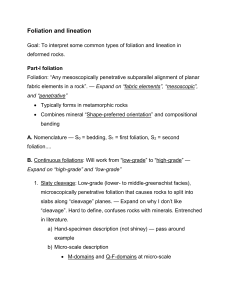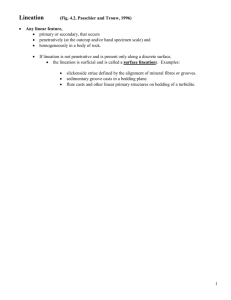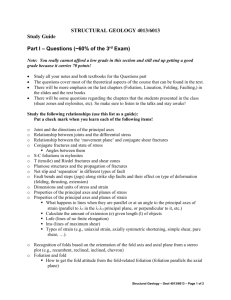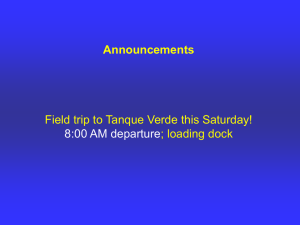Lab 6: Fabrics and folds
advertisement
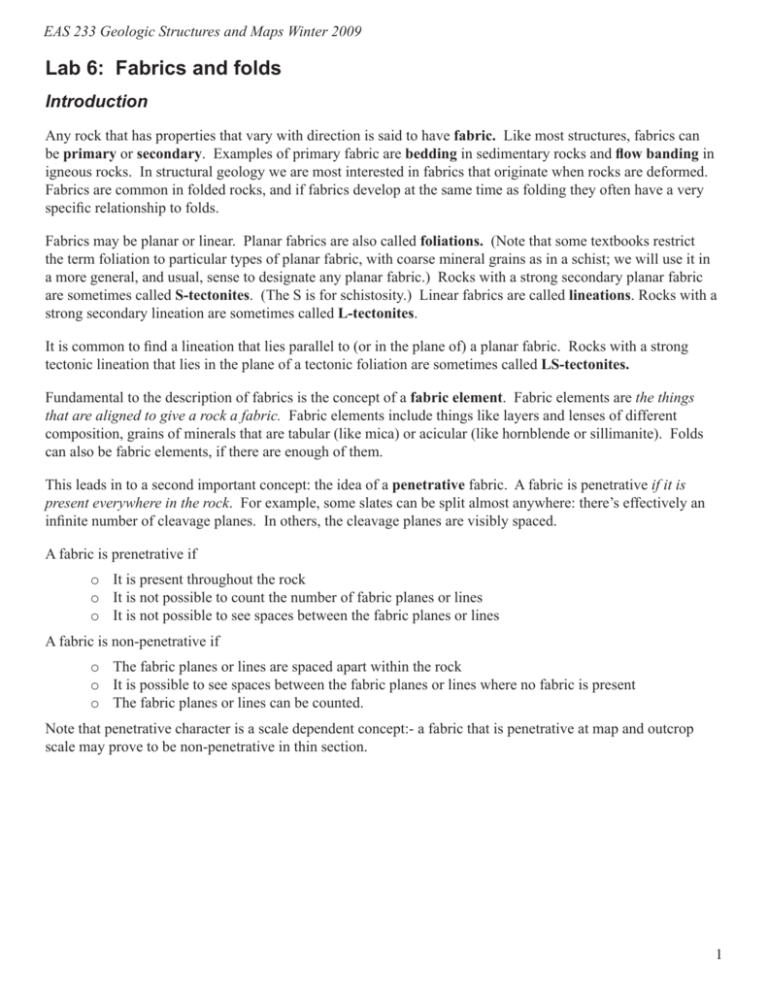
EAS 233 Geologic Structures and Maps Winter 2009 Lab 6: Fabrics and folds Introduction Any rock that has properties that vary with direction is said to have fabric. Like most structures, fabrics can be primary or secondary. Examples of primary fabric are bedding in sedimentary rocks and flow banding in igneous rocks. In structural geology we are most interested in fabrics that originate when rocks are deformed. Fabrics are common in folded rocks, and if fabrics develop at the same time as folding they often have a very specific relationship to folds. Fabrics may be planar or linear. Planar fabrics are also called foliations. (Note that some textbooks restrict the term foliation to particular types of planar fabric, with coarse mineral grains as in a schist; we will use it in a more general, and usual, sense to designate any planar fabric.) Rocks with a strong secondary planar fabric are sometimes called S-tectonites. (The S is for schistosity.) Linear fabrics are called lineations. Rocks with a strong secondary lineation are sometimes called L-tectonites. It is common to find a lineation that lies parallel to (or in the plane of) a planar fabric. Rocks with a strong tectonic lineation that lies in the plane of a tectonic foliation are sometimes called LS-tectonites. Fundamental to the description of fabrics is the concept of a fabric element. Fabric elements are the things that are aligned to give a rock a fabric. Fabric elements include things like layers and lenses of different composition, grains of minerals that are tabular (like mica) or acicular (like hornblende or sillimanite). Folds can also be fabric elements, if there are enough of them. This leads in to a second important concept: the idea of a penetrative fabric. A fabric is penetrative if it is present everywhere in the rock. For example, some slates can be split almost anywhere: there’s effectively an infinite number of cleavage planes. In others, the cleavage planes are visibly spaced. A fabric is prenetrative if o It is present throughout the rock o It is not possible to count the number of fabric planes or lines o It is not possible to see spaces between the fabric planes or lines A fabric is non-penetrative if o The fabric planes or lines are spaced apart within the rock o It is possible to see spaces between the fabric planes or lines where no fabric is present o The fabric planes or lines can be counted. Note that penetrative character is a scale dependent concept:- a fabric that is penetrative at map and outcrop scale may prove to be non-penetrative in thin section. 1 EAS 233 Geologic Structures and Maps Winter 2009 Fabric elements of foliations The following types of fabric elements can give a rock a foliation. Notice that it’s common for a given foliation to be defined by a combination of fabric elements, as shown in figure 1. Tabular mineral grains: Platy or flake-shaped mineral grains like mica are often aligned to produce a foliation Acicular mineral grains: Less obviously, needle-shaped mineral grains may contribute to foliation if they are distributed parallel to a plane. Crystallographic preferred orientation (CPO): Sometimes it is necessary to look at a thin section under the microscope to see a fabric. If the crystallographic axes of a particular mineral are all parallel to a particular plane, then the rock has a foliation. Typically this will only become obvious when the microscope stage is rotated between crossed polars, especially when a 1-lambda plate is inserted; all the grains change colours ‘in synch’ as the stage is rotated. Domains: A domain is a region within a rock that has a distinctive composition or texture. Flattened clasts in a sedimentary rock can produce a foliation if they are all aligned parallel to a plane. Layers: Layers are really special domains that are very extensive and parallel-sided. Cracks or discontinuities: Closely spaced fractures can produce a type of cleavage called fracture cleavage. Fold axial surfaces: Numerous closely spaced fold axial surfaces may be planes of weakness in highly deformed rocks. This structure is called crenulation cleavage. Common types of foliation, and their origins Primary fabrics: Sedimentary rocks are typically recognized by their primary fabrics. Actually, two types of primary fabric are common: o Bedding and lamination are defined by layers of different composition or texture, typically reflecting environmental change during deposition; o Fissility is a fabric characteristic of mudrocks, in which the sheet silicates have been aligned by compaction to produce a penetrative primary foliation. Slaty cleavage: Slaty cleavage is a penetrative fabric in which micas or other sheet silicates, below the limit of visibility with the naked eye, are aligned parallel to a plane, which becomes an easy plane of splitting. Strain studies have shown that slaty cleavage typically forms perpendicular to the direction of maximum shortening, the S3, or Z axis of the strain ellipsoid. In other words, cleavage forms parallel to the S1-S2, or X-Y plane. Some slaty cleavages are penetrative down to the scale of individual mineral grains; others show domains under the microscope. Cleavage is thought to develop by a combination of processes including: o Physical rotation (transposition) of mineral grains as a rock is deformed o Solution of grains subjected to high stress (pressure solution) o Growth of new mineral grains during deformation. Slaty cleavage is the defining characteristic of the rock type slate. Schistosity: Schistosity is a coarser grained version of slaty cleavage, and is the term used for a more or less penetrative foliation defined by mineral grains coarser than about 1 mm. Many geologists actually recognize 2 EAS 233 Geologic Structures and Maps Winter 2009 an intermediate feature phyllitic foliation, when the fabric-defining minerals are just visible. However, the boundaries between these categories have never been formally defined. Schistosity involves the same types of process as slaty cleavage, but is typical of higher metamorphic grades and always involves significant new mineral growth. Flattening fabric: When a foliation is defined by domains that represent identifiable deformed objects in a rock, such as flattened pebbles in a deformed conglomerate, the fabric can be called a flattening fabric. (Most foliations are probably produced by flattening, but this term is used when the origin is obvious.) Pressure-solution cleavage: Sometimes deformed rocks contain domains or layers of different composition that can be shown to have originated as a result of solution of particular minerals. For example, quartz may be preferentially dissolved from certain bands within a rock, producing mica-rich seams that separate quartz-rich lithons. Crenulation cleavage: Crenulation cleavage is defined by closely spaced fold axial surfaces. It’s almost always a second or later generation of fabric: an initial deformation produces a foliation and later deformation folds that foliation to produce a crenulation cleavage. Sometimes crenulation cleavage is combined with pressure solution to produce differentiated crenulation cleavage. Mylonitic foliation: Extreme ductile shearing in shear zones tends to reduce the grain size of mineral grains, while stretching the original grains out into domains of extreme dimensions, and also producing strong crystallographic preferred orientation. This type of foliation is called mylonitic foliation. It’s almost always accompanied by a lineation, producing an LS-fabric. Relationships of foliation to folds Foliations are often developed parallel, or roughly parallel, to the axial surfaces of folds. This relationship is common because both structures originate from the same strain. Fabric planes and fold axial surfaces are perpendicular to the shortening direction, the short axis of the strain ellipsoid (Z or S3). Foliation of this type is called axial planar foliation (or axial planar cleavage, etc. depending on the type of foliation.) In detail, axial planar foliations often depart from exact parallelism with the axial surface of a fold, because of local strain variation. One very common style is called cleavage refraction in which cleavage bends so that it is more perpendicular to competent layers, and more parallel to incompetent layers. This reflects the varying amount of flexural slip in different materials. The axial planar relationship is very useful when disentangling superimposed folds. It’s conventional to number fold generations, starting with the earliest, as F1, F2, F3 etc. The corresponding axial planar foliations are called S1, S2 etc., where S1 is axial planar to F1, but is folded by F2. Sometimes the numbering scheme is even extended to bedding, which is labelled S0. 3 EAS 233 Geologic Structures and Maps Winter 2009 Figure 1: after Hobbs, B.E., Means, W.D, and Williams P.F., 1976. An Outline of Structural Geology Wiley 1976. © Reproduced under license from Cancopy. Further copying prohibited. 4 EAS 233 Geologic Structures and Maps Winter 2009 Fabric elements of lineations The following types of fabric elements can give a rock a lineation. Notice that it’s common for a given lineation to be defined by a combination of fabric elements, as shown in figure 2. Acicular mineral grains: Needle-shaped, or acicular, mineral grains like amphibole and sillimanite are often aligned to produce a lineation. Tabular mineral grains: Less obviously, tabular mineral grains may contribute to lineation if their orientations are scattered so that their planes all include a particular line. Crystallographic preferred orientation (CPO): If the crystallographic axes of a particular mineral are all parallel to a particular line, then the rock has a lineation. Typically this will only become obvious under the microscope. Domains: A domain is a region within a rock that has a distinctive composition or texture. Elongated domains can define a lineation. For example, stretched clasts in a sedimentary rock can produce a lineation if they are all aligned parallel to a line. Rods: Rods are really just domains that are very elongated and continuous. Fold hinges: Numerous closely spaced fold hinges may produce a lineation in highly deformed rocks. This structure is called crenulation lineation. Intersecting foliations: Whenever two intersecting foliations are present, there is always an intersection lineation defined by their intersection. In the field, although it’s possible to calculate the intersection lineation from strike-and-dip measurements of the two foliations, it’s usually much more accurate to measure the lineation directly. Common types of lineation, and their origins Primary lineations: Primary lineations are less common than primary foliations. Typically, primary lineations in sedimentary and igneous rocks both reflect flow direction. Mineral lineations: Mineral lineations are the linear equivalent of slaty cleavage and schistosity. Strain studies suggest that mineral lineations typically form parallel to the direction of maximum extension, the S1, or X axis of the strain ellipsoid. Like their planar counterparts. they probably form by a combination of grain rotation, solution, and grain growth during deformation. Stretching lineation: When a lineation is defined by domains that represent identifiable deformed objects in a rock, such as stretched pebbles in a deformed conglomerate, the fabric can be called a stretching lineations. Crenulation lineation: Crenulation cleavage is defined by closely spaced fold hinges. It’s almost always a second or later generation of fabric: an initial deformation produces a foliation and later deformation folds that foliation to produce a crenulation lineation. Crenulation lineation is almost always visible when crenulation cleavage is present. Mylonitic lineation: Extreme ductile shearing in shear zones tends to reduce the grain size of mineral grains, while stretching the original grains out into domains of extreme dimensions, and also producing strong crystallographic preferred orientation. This variety of stretching lineation is called mylonitic lineation. It’s almost always accompanied by a foliation, producing an LS-fabric. 5 EAS 233 Geologic Structures and Maps Winter 2009 Relationships of lineation to folds In folds with axial planar foliations, an intersection lineation is formed where the cleavage planes cut through the folded surfaces. If the folds are reasonably cylindrical, this intersection lineation is parallel to the fold axis. Measuring the intersection lineation is therefore a valuable way of finding fold axis orientations in areas where fold hinges, inflection lines, etc., are not well exposed. Sometimes a second lineation can be seen in folded rocks with axial planar slaty cleavage. This lineation takes the form of faint streaks on the cleavage surfaces at a high angle to the fold hinges. It’s sometimes called a down-dip lineation from its orientation in areas of gently plunging folds. It probably originates as a stretching lineation, and represents the long axis of the strain ellipsoid (X or S1). In higher grade rocks, sometimes stretching lineations (or mineral lineations thought to be formed by stretching) are found parallel to fold hinges. This is usually an indication that extreme shearing has occurred, with the generation of sheath folds. These will be considered in more detail when we deal with mylonites later in the course. In areas with multiple generations of fabrics and folds, lineations are typically numbered L1, L2 etc., to correspond with fold and foliation generations. Figure 2: after Hobbs, B.E., Means, W.D, and Williams P.F., 1976. An Outline of Structural Geology Wiley 1976. © Reproduced under license from Cancopy. Further copying prohibited. 6 EAS 233 Geologic Structures and Maps Winter 2009 Assignment 1. To illustrate the concept of fabric elements, you are provided with some everyday objects with simple fabric. For each fabric, determine o o o o 2. Is the fabric a foliation or a lineation? What are the fabric elements that define the fabric. What shape are the fabric elements (tabular, acicular, some combination). If the object were a rock sample, does the fabric have a common geologic name (e.g. slaty cleavage, stretching lineation etc.) Look at one rock sample from each group. Note that some of the samples have more than one fabric. For each fabric, determine o o o o Is the fabric a foliation or a lineation? Describe the fabric elements that define the fabric. Does the fabric have a common name (slaty cleavage, crenulation lineation, etc.) What is the relationship of the fabric to other fabrics in the rock? Where possible, number the fabrics S1, S2, L1, L2 etc.... 3. You are provided with a map of a group of glacially smoothed, low-lying islands showing metamorphic rock outcrops. The structures are typical of the deeply eroded cores of many orogens. There are two generations of folds, with associated fabrics and asymmetric parasitic folds. A penetrative schistosity is present everywhere, together with a locally developed crenulation cleavage, and a crenulation lineation. In a few places, it’s possible to see an intersection lineation between bedding and the schistosity, though these two foliations are almost parallel in many outcrops, indicating that deformation has been intense. a. Using an equal area projection, plot the orientations of the schistosity as poles. b. Look at the folds on each island in turn. Notice that some of the folds deform the bedding but not the schistosity; these folds have axial planar schistosity, and therefore probably formed at around the same time as the schistosity. These folds are the first generation that can be identified in the area. Label them F1, in a distinctive colour such as red. Other folds clearly formed after the schistosity because they fold the schistosity. Label these folds F2 in a contrasting colour such as blue. c. For each F2, label the fold as S or Z based on its asymmetry. Use the same colour that you used to identify F2 folds. d. Using your results from b and c, draw and label the principal fold axial trace for an F2 map-scale fold. Remember, a fold axial trace will separate S and Z senses of asymmetry. Label it using the F2 colour. e. From your equal area projection, estimate the orientation of the F2 fold axis. Both the axis and the axial trace are lines that lie in the axial surface. Use these two lines to draw the axial surface as a great circle on your projection and determine its orientation. Add the crenulation cleavage and crenulation lineation to your projection. What is their relationship to the folds? f. For each F1 fold, label it as S or Z based on its asymmetry, using the F1 colour. Draw the F1 axial traces on the map. (Remember, the F1 folds will probably have been refolded by F2, so you should not expect their traces may not be straight!). Assuming the chlorite schist is the youngest unit, characterize the main F1 folds as either anticlines or synclines. g. Add labels S1, S2, L1 etc. to the legend where indicated by ‘.....’ Complete the map as far as possible in the unexposed areas between the islands to show the overall structure. (To help visualize the structure, you may wish to sketch a cross-section AB, but this is not required.) h. What type of fold interference pattern is present? 7 213/31 134/60 Quartzite bed Muscovite schist Chlorite schist Trace of schistosity ..... 295/89 287/77 253/40 225/32 225/32 180/33 217/31 Orientation of crenulation lineation ....... Orientation of crenulation cleavage...... Orientation of bedding-schistosity intersection .......... Orientation of schistosity .......... A 00023 294-23 290/82 248/42 B 294-31 250/37 250/39 294-31 220/32 282/69 N 100 m EAS 233 Geologic Structures and Maps Winter 2009 8

